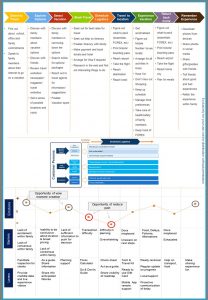
Here are 7 problems and their impact of Poor Client centricity in B2B Sales Teams:
- Lack of trust and credibility: Without a clear understanding of the client’s needs, wants and pain points, it can be difficult for salespeople to build trust and establish credibility with potential customers.
- Difficulty in differentiating products or services: Poor client centricity can make it difficult to effectively communicate the unique value of products or services to potential customers, which can make it more challenging to differentiate and win deals.
- Lack of effective value proposition: Without a clear understanding of the client’s needs, it can be difficult to create an effective value proposition, which can make it challenging to close deals.
- Poor lead qualification: Without proper client centricity, it can be difficult to identify and qualify leads that are most likely to convert into customers.
- Difficulty in retaining customers: Poor client centricity can lead to a lack of understanding of the client’s needs, which can make it more challenging to retain customers over the long-term.
- Difficulty in upselling and cross-selling: Without a clear understanding of the client’s needs, it can be difficult to identify opportunities for upselling and cross-selling, which can limit revenue growth.
- Difficulty in understanding the client’s industry and business environment: Poor client centricity can make it difficult to understand the client’s industry and business environment, which can make it challenging to anticipate and respond to changes in the marketplace.
Free Download
Download your copy of a research report on customer experience trends in India.
There are many trend trackers to present a global perspective of CX, but there aren’t many in India. We have seen that many global trends apply to India, only with subtle difference. This report contains key observations about evolving CX trends in India.

#nilakantasrinivasan-j #canopus-business-management-group #B2B-client-centric-growth #Sales-transformation

B2B companies may find it difficult to improve NPS or client satisfaction for a variety of reasons, including:
- Complex products or services: B2B companies often offer complex products or services that are difficult for customers to understand or use. This can lead to confusion and dissatisfaction among customers.
- Long sales cycles: The B2B sales cycle is often longer than the B2C sales cycle. This can lead to delays in the delivery of products or services and can cause dissatisfaction among customers.
- Lack of personalization: B2B companies often deal with multiple decision-makers and stakeholders within a single organization, which can make it challenging to personalize the customer experience.
- Limited customer interactions: B2B companies may have fewer interactions with customers than B2C companies, which can make it difficult to gather customer feedback and identify areas for improvement.
- Limited resources: B2B companies may have limited resources to devote to customer satisfaction initiatives, such as hiring customer service representatives or investing in customer feedback systems.

Meeting Service Level Agreements (SLAs) in B2B organizations can be difficult for a variety of reasons, including:
- Complex products or services: B2B companies often offer complex products or services that require specialized knowledge or expertise to maintain or repair. This can make it difficult to meet SLAs for repair or maintenance times.
- Long sales cycles: The B2B sales cycle is often longer than the B2C sales cycle. This can lead to delays in the delivery of products or services and can make it difficult to meet SLAs.
- Limited resources: B2B companies may have limited resources to devote to meeting SLAs, such as hiring additional staff or investing in new equipment.
- Lack of standardization: Different customers may have different expectations for service and support, which can make it difficult to standardize SLAs across all customers.
- Dependence on third-party vendors: B2B companies may rely on third-party vendors to provide certain products or services, which can make it difficult to control and meet SLAs.
- Limited visibility: B2B companies may have limited visibility into the performance of their products or services after they are delivered to the customer, which can make it difficult to identify and address issues that are impacting SLA performance.
If your are looking for improving ways to meet your SLAs, please contact us
#nilakantasrinivasan-j #canopus-business-management-group #B2B-client-centric-growth #SLA

Sustaining client centricity can be difficult for a number of reasons, including:
- Resistance to change: Implementing a client-centric approach may require changes to existing processes and ways of doing things, which can be met with resistance from employees who are comfortable with the status quo.
- Lack of understanding: Without proper training and education, employees may not fully understand the benefits of a client-centric approach or how to implement it effectively.
- Limited resources: A client-centric approach may require additional resources, such as increased staff or technology, which may not be available.
- Lack of accountability: Without clear accountability and oversight, it can be difficult to ensure that a client-centric approach is being implemented and maintained.
- Difficulty in Measuring Success: Without clear metrics to measure the success of a client-centric approach, it can be difficult to evaluate its effectiveness and make adjustments as needed.
#nilakantasrinivasan-j #canopus-business-management-group #B2B-client-centric-growth #Client-centricity

Agile enterprises are customer centric because they prioritize the needs and goals of their customers in all aspects of their business. Agile methodologies, such as Scrum and Kanban, are designed to be flexible and responsive to change, which allows organizations to quickly adapt to the evolving needs of their customers.
In an agile enterprise, customer feedback is actively sought and incorporated into product development and decision-making processes. This allows the enterprise to continuously improve and deliver products and services that align with customer needs.
Additionally, Agile enterprises also tend to have a flat organizational structure, which allows for better communication and collaboration across teams and departments, enabling them to respond more quickly to customer needs. They also tend to use cross-functional teams, which are composed of individuals from different areas of the business, such as design, development, and marketing, to work together to deliver products and services that meet customer needs.
In summary, Agile enterprises are customer centric because they prioritize the needs of their customers, actively incorporate customer feedback, and continuously improve their products and services to meet those needs.
One example of how agility helped in client centricity is the case study of a large retail bank that implemented an Agile approach to managing their customer service operations.
The bank was facing a significant challenge in maintaining high levels of customer satisfaction, as their traditional, hierarchical structure was causing delays in responding to customer complaints and requests. Additionally, the bank was facing increased competition from fintech companies that were more agile and able to respond quickly to changing customer needs.
To address these issues, the bank decided to adopt an Agile approach to managing their customer service operations. They formed cross-functional teams composed of representatives from different areas of the business, such as customer service, IT, and compliance, and implemented daily stand-up meetings to ensure that everyone was aware of the most pressing customer issues.
The bank also began actively seeking customer feedback and incorporating it into their decision-making processes. They also implemented a system for tracking customer complaints and requests in real-time, which allowed them to quickly address and resolve issues.
As a result of these changes, the bank was able to significantly improve their customer satisfaction levels and reduce their customer complaint resolution time. The agility helped them respond to the changing customer needs in a timely manner. Additionally, the bank was also able to reduce costs and improve overall efficiency, which helped them better compete with fintech companies.
This case study shows how agility helped in client centricity by allowing the bank to respond more quickly to customer needs, improve customer satisfaction, and ultimately increase competitiveness.
One example of agile client centricity in a startup is the case study of a small software development company that specializes in building custom mobile apps for small businesses.
The company had struggled to retain clients in the past because they were not able to deliver products that met the unique needs of each business. The company decided to adopt an Agile approach to software development, which allowed them to be more flexible and responsive to the evolving needs of their clients.
The company began using Scrum, an Agile methodology, to manage their software development projects. They formed small, cross-functional teams composed of developers, designers, and project managers, and held daily stand-up meetings to ensure that everyone was aware of the most pressing client needs.
The company also began actively seeking client feedback and incorporating it into their development process. They implemented a system for tracking client requests and issues in real-time, which allowed them to quickly address and resolve problems.
As a result of these changes, the company was able to significantly improve their client retention rate. Clients were happy with the product as it met their needs and the company was able to deliver the product on time and on budget. Additionally, the company was able to reduce costs and improve overall efficiency, which helped them to better compete with larger software development companies.
This case study shows how agility helped in client centricity by allowing the company to respond more quickly to client needs, improve client satisfaction and ultimately increase competitiveness.
Here are a few simple ways to start incorporating Agile principles in a non-software environment:
- Start with small, cross-functional teams: Form teams that include representatives from different areas of the business, such as sales, marketing, and operations. This will ensure that everyone is aware of the most pressing customer needs and can work together to deliver solutions.
- Hold regular meetings: Hold daily or weekly meetings to discuss progress, identify any roadblocks, and ensure that everyone is on the same page.
- Prioritize customer feedback: Actively seek and incorporate customer feedback into decision-making processes. This will help ensure that products and services align with customer needs.
- Emphasize flexibility and adaptability: Be open to change and willing to pivot when necessary. Agile is all about being able to respond quickly to changing circumstances.
- Use visual management tools: Use visual tools, such as Kanban boards or task lists, to track progress and identify areas for improvement.
- Encourage collaboration and communication: Encourage open communication and collaboration across teams and departments.
- Test and Iterate: Continuously test and improve the process, gather feedback, and iterate.
It is important to note that Agile is a mindset and a set of principles, not a one size fit all methodology. Therefore, it’s important to tailor the approach to the specific needs of the organization and its environment.
#nilakantasrinivasan-j #canopus-business-management-group #B2B-client-centric-growth #Agile #Customer-centric

Inspiration is contagious like COVID!
I’m an artist at living – my work of art is my life.
– Suzuki
Be passionate about designing customer experience. Take personal interest in finer details of your product/service, even if its too insignificant for your role.
| If a picture is worth 1000 words, a prototype is worth 1000 meetings. |
| – Tom & David Kelley |
It’s best to create a culture to experiment, test & pilot the hypothesis rather than deliberation, debate & finalize!
| Mind is never a problem, mindset is. |
| – Narendra Modi |
All employees are good, any mind-block that makes someone pro or anti to a change is due to lack of clarity. Communicate beyond barriers to build strong bridges and change mindsets.
| The more you engage with customers the clearer things become and the easier it is to determine what you should be doing. |
| – John Russell |
| Set it as your personal target to interact with at least 1 customer everyday, even if it is in an informal manner. |
| _____________________________________________________ |
| A little rain each day will fill the rivers to overflowing. |
| – Liberian Proverb |
| Leaders need to repeatedly and regularly connect with employees to emphasize the importance of customer experience. It’s not a one time fan fair event. |
| _____________________________________________________ |
| The customer is not always right, but they are always your customer! |
| – Shep Hyken |
| It doesn’t matter who’s right, any way. Not all customers will fit into ideal customer profile. This agile mindset is the starting point for customer delight. |
| _____________________________________________________ |
| Don’t confuse customers who are to your company with customers who are loyal to your loyalty program. |
| – Sky |
| Not all customers are loyal. Don’t get misled by rewards redemptions and impressions rates to gage customer engagement. |
| _____________________________________________________ |
| Use your good judgment in all situations. There will be no additional rules. |
| – Nordstrom’s employee manual |
| Processes, control measures, audits & automations should empower your employees to serve customers better and not meant to turn employees into robots that follow rule & script books. |
#nilakantasrinivasan-j #canopus-business-management-group #B2B-client-centric-growth #Customer-Experience #Leadership-quotes
Triangulation can help sustaining solutions and strengthening analysis.
When your organization faces a problem, sooner or later, there will be an action plan in place to abet its elimination. The inconvenient truth about solutions is that they have long tails. Very, very few solutions actually stick. Most of them seem to be gone in months, sometimes even weeks and the problem bounces back. Yes, I’m talking about lack of permanence to the actions taken to improve performance.

There are several theories and in-depth research but, from my experience, I can say that things haven’t changed much in the last 2 decades. Whether it’s automation, change management, top-down push, leadership sponsorship, incentives, rewards, recognition or culture fix, all of them are marked by only a certain success rate.
My other post, On recurring problems, 3L 5W & what’s wrong with it… explains a method to identify system level root causes. Triangulation can be used for validation of root cause and to evaluate the effectiveness of any solution.
Validation through Triangulation
Triangulation is a method that involves combining multiple sources or methods to validate an analysis or its outcomes. We are used to taking a second opinion from another medical professional before committing to an incisional treatment. That is an everyday example of triangulation. The origin of triangulation dates back to Greek civilization. In the last 2 centuries, it is very commonly used in maritime navigation, civil engineering and surveying, where it relies on sound trigonometry. In fact our GPS uses this very same principle to establish the lat-long of a location. Triangulation is also a very popular research method to validate results, findings and even for monitoring the sustenance of interventions, such as social welfare initiatives.
In business while validating root causes, triangulation comes very handy. If we can validate the root cause by more than one means, it strengthens our analysis and confidence in our actions. Financially too, it makes sense, as ROI is higher.

I consider Triangulation as it can also generate new and credible findings about a situation or phenomenon and can create new ways of looking at a situation or phenomenon.
Interestingly, it helps to overcome human behavioral bias, which is the biggest spoiler when it comes to organizational deployment. It helps to explore and explain complex human behavior using a variety of methods and observers to offer a more balanced explanation for a phenomenon.

Customer Attrition Example for Triangulation:
Let’s say, your organization faces unusual customer attrition. In general, you will collect and analyze data of customer activity by segments, such as customer journey, cart abandonment, milestones or events, complaints, etc to identify the reasons for customer attrition. Using triangulation, you can consider parallel methods such as customer interviews and front line employee interviews. You will independently gain insights from these 3 different methods viz., data, customer interviews & employee interviews to validate the outcomes. The results can either converge, complement or diverge from each other.
Interpretation of Triangulation Results
When all the three sources conclude that customer attrition is because of poor product support, we call this Convergence. That is, the results of the different methods lead to the same conclusion.
When all the three sources conclude that the customer attrition is because of poor product support, but in the customer interviews, we learn that customers prefer self-service which is a weak link of your product line, then triangulation has led to Complementarity.
When the three sources provide different outcomes, one pointing towards product support, another towards pricing and third towards customer behavior, then we are in a stalemate or Divergence. This is a concerning situation as it either highlights issues with the methods or with the very problem itself.
Triangulation Options
Depending on the objectives, triangulation can be done at different levels:
- Data Triangulation – Using different data sources to validate. Ex: Customer activity database vs Customer Satisfaction database
- Method Triangulation – Using different methods to validate. Ex: Data Analysis Vs Customer Interviews
- Investigator Triangulation – Using different individuals to validate there by eliminating appraiser bias
While triangulation offers many benefits, you have to be careful in selecting the right methods and planning the analysis. In general, it can consume more time that quick action mode, but will reduce failures, increase sustenance and success rates.
You can also consider triangulation for verifying sustenance of initiatives, selection of vendors or new employees
#nilakantasrinivasan-j #canopus-business-management-group #B2B-client-centric-growth #Triangulation

While organizations like Disney and Ritz-Carlton have the luxury to hire front line staff based on Emotional Quotient (EQ), you will agree that not all of us have that levy. More importantly, in some sectors we have to weigh other skills such as technical, financial, engineering, software than EQ during hiring. For example, in product service, B2B front line, IT solutioning, etc., it is not a pragmatic aspiration to expect employees to possess high EQ & technical know-how.
Over the years, employees have understood the importance of customer centricity. So everyone wants to be customer centric but the question really is, how? Are the specific pointers that CXOs & HODs can give to their team on what to do? Motivating & inspiring them to do so is just as good as cranking the engine. What about throttling and shifting gears?
Unfortunately, there are very few leaders who go that far. If you want your employees to emulate certain behavior everytime-everyday, you have to be very specific and take a prescriptive approach.
Here are the 8 super simple behaviors that you can demonstrate every day, in meetings, field visits, reviews, planning, brainstorming sessions, or even when you scroll down a spreadsheet. Every customer facing employee (rather every employee) can be encouraged to imbibe these practices to become customer centric that will facilitate value generation for customers & business.
We will start with the simplest and go down to the difficult ones.
- Consistently deliver on promises: This is the simplest way to build trust and usually doesn’t cost much. And promises, whether big or small, are what we voluntarily make! So, it’s pretty much in our control.
- Permanent Issue Resolution: Whatever technology and processes we put in place, problems do crop up, every now and then. These issues are irritants for customers. Imagine, how many different products and services he/she uses. If we learn to go to the root of the customer issue and fix it permanently, we are not only helping this customer, but proactively preventing many such issues. This is when we can devote our energies towards constructive strategies.
- Collaborate together to fix customer issues: Organizations have become complex systems and authority is largely decentralized. Unless we collaborate internally and externally with all stakeholders, we will never put up a good show in front of customers.
- Listening to customers and understanding their needs: While it sounds very simple, it’s important to recognize every customer is unique. Furthermore, needs and requirements are very different. And lest, we have time to listen.
- Look for ways to make things better for our customers: Unearthing the unarticulated needs of customers pushes it by one more notch. Real and productive innovation starts here.
- Going out of way to help customers: We are trained to follow rules, processes and policies. Many a time, the biggest hindrance to customer centricity are none but these factors. The courage to challenge and break them when the situation really warrants is not short of heroism in Customer Centricity.
- Keep customers at the heart of our decisions: We are in business and not in charity, but when it comes to day to day decisions, do we weigh customers equally as business?
- Serve with Passion: While the first 6 points hinged on skill & action, the last two are about will. Conviction is born at the bottom of the heart.
If you wish to learn more about these 8 behaviors or how to create buzz around customer centricity in your organization, happy to be of help any time.
#nilakantasrinivasan-j #canopus-business-management-group #B2B-client-centric-growth #Customer-Centricity
Customer Journey Mapping Definition:
Customer Journey Mapping (CJM) is a framework to explore all possible scenarios of customer’s journey so that we can implement the best design. It plays an very important role in Customer Experience (CX) Management and Customer Experience Re-design.
As an approach, in Customer Journey Mapping, we create a map of the customer’s journey to shop, journey to buy and journey to use our products or services. Thus Customer Journey Mapping is a Design Thinking Tool that is aimed at improving our understanding of customers and their needs.
Salient Features of Customer Journey Mapping
When you start a journey map, the emphasis is more improving our understanding rather than focusing on its accuracy. So you can choose to assume how the customer’s journey is or ought to be and create a customer journey map. Using this as a starting point, you frame few hypotheses and then using customer research, validate if it those are true. This way, you can challenge status quo, empathize with the customers and better understand their needs.
As a result, Customer Journey Map is created based strong experimentation or fact validation. It is a factual map of how the customers get things done. So, you can create a Customer Journey Map, even when you don’t have a product or service to cater to customer needs. All you are trying to do is map the customer’s journey from inception to exit, though in major part of this journey, the customer may or may not even interact with your products and services.
One of the big differences or advantages of Customer Journey Map is that, it takes a holistic view of the entire customer journey rather than fixing isolated events. Such isolated improvements are very common general practice in the industry. They can relieve customer pain points but cannot help you re-invent or re-design the entire customer experience. Instead of choosing such piece meal approaches go for Customer Journey Mapping.
Benefits of Customer Journey Mapping
Typical benefits of Customer Journey Mapping includes improvement in Customer Retention, revenue enhancement through up sell, cross sell and share of wallet improvement, increase in customer experience (CX), customer satisfaction (C-Sat) & customer loyalty (NPS), ability create wow moments or delights for customer and the power to emotionally connect with the customer.
Customer Journey Mapping Training Course
If you want to learn to create customer journey maps, you can visit our online courseCustomer Experience Quotes
Here is one of the most inspiring Customer experience quotes to delight customers and customer retention.Do not be in a hurry to tie what you cannot untie.
– English Proverb
Take away for CX Professionals
Overpromising is a bad strategy when it comes to customer retention.
Author is an expert in customer retention. If you are looking for Customer Experience (CX) firm in Chennai, Bangalore, Mumbai, Delhi and across India, contact us.
Customer Experience Quotes
Here is one of the most inspiring Customer experience quotes to delight customers and customer retention.Welcome the coming, speed the parting guest.
– Homer
Take away for CX Professionals
It’s good news when some customers leave you.
Author is an expert in customer retention. If you are looking for Customer Experience (CX) firm in Chennai, Bangalore, Mumbai, Delhi and across India, contact us.
Customer Experience Quotes
Here is one of the most inspiring Customer experience quotes to delight customers and customer retention.All looks yellow to the jaundiced eye.
– Alexander Pope
Take away for CX Professionals
Introspection is an effective tool to arrest customer churn.
Author is an expert in customer retention. If you are looking for Customer Experience (CX) firm in Chennai, Bangalore, Mumbai, Delhi and across India, contact us.
Sign-up for collaborat newsletter

